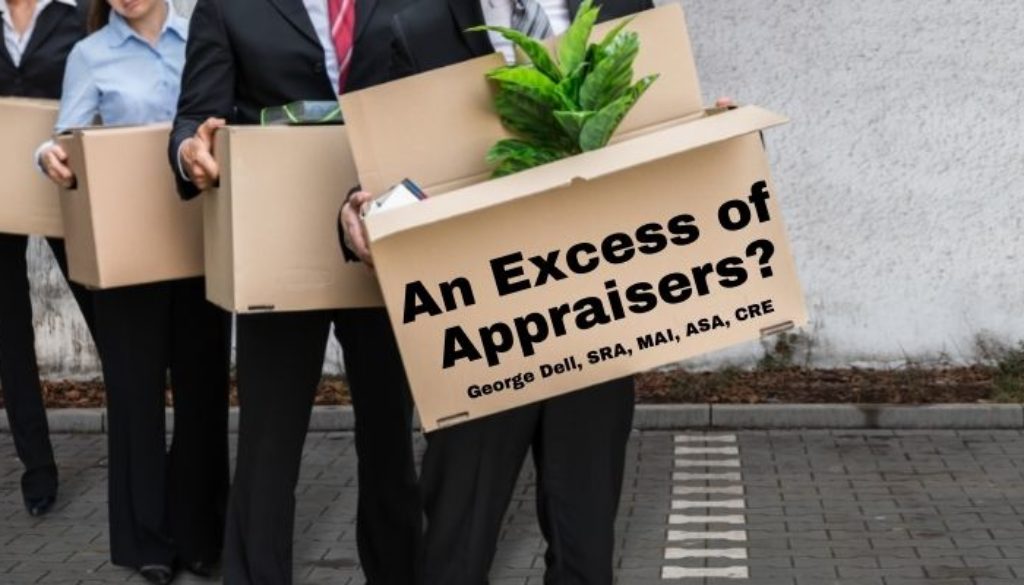How can we fix the excess of appraisers? Easy — we do what we have always done, each time . . .
1) We will raise the standards (“cost of entry”). 2) We will make it harder to become an appraiser; 3) Let the lower fees discourage newcomer appraisers.
In past issues of the Analogue Blog, we have considered the “five forces of friction” on the advancement of appraisal. Here we consider how these “frictions” will behave as appraisal demand has dropped, just as each of the five forces have found ways to reduce or “eliminate” the need for valuation expertise. Recall the five forces of friction: practices, standards, education, regulation, and client expectation.
In this blog, we can consider how each friction will respond to this “excess” of appraisers.
Practices:
Current practice is still embedded in the concepts of 8 ½ X 14 paper forms, spreadsheets, or narrative explanation of the opinion of the person (appraiser, evaluator) or automation programmer. Practices will continue to evolve toward objective data selection and predictive models. But this evolvement will continue to stay behind the inherent potential of applied data science. Habitual practice of “comparing comps” over “measuring markets” will prevail (in the absence of change in the other “frictions”).
Standards:
Appraisal standards are entirely focused on prescribed appraiser behavior. Evaluations recognize the acceptability of lower requirements, and can be done by appraisers under the guise of being a “restricted” report. Current USPAP requires credibility, defined as being “worthy of belief.” The issue here is the goal: subjective believability, not objective reliability. (Worthiness, not analytic result).
Education:
Current education will likely stay the same, perhaps with even greater emphasis on the “established and recognized body of knowledge.” Recent actions by the Appraisal Institute seem to have doubled down on the goodness of the historic, well-established practices. This to the exclusion of state-of-the-art econometric principles and modeling expertise, and computational algorithms with visual interface.
Client expectation:
Valuation products are delivered to the intended users, appraisal “reviewers,” who then implement the collateral side of loan decisions. Investors commonly use back-of-the-envelope thinking, comparing comps, and relying on competent and the careful comp-comparing of appraisers. (Even as complete transaction information is instantly available in most areas.)
Client organizations generally are internally influenced by licensed (or even designated) appraisers, who ‘grew up’ enveloped by the same education, expectations, and regulations.
Regulation:
Current considerations of regulatory reform may turn the tide “there is a chance . . .” . I am not optimistic, but have witnessed a genuine and broad viewing of input, and objective thinking.
It is clear to me that licensing of appraisers has not ‘solved’ the recurring economic crises. Licensing has resulted in an overall decline (in my opinion) in valuation reliability, unbiasedness, and usefulness. Instead of a higher goal, licensing set a lowered bar.
So long as regulation embeds vintage “appraisal practices and procedures, the other frictions will also embed outdated practices. The enablement of personal bias via analytic subjectivity (picking comps) will continue. The appraiser community will continue to be an easy target for accusations of bias.
Current “approval” of education by 54 state and territorial groups – inhibits real modernization. On a personal note, the data-science oriented education of Valuemetrics.info: 54+ agencies require around 120 forms (class, instructor, and school ‘approvals’). The dollar costs of these absorb over half the fees charged appraisers. Modernization is stymied.
The only positive hope – is regulatory change. Currently, FFIEC (The Federal Financial Institutions Examination Council) – along with the FHFA, (controlling the GSE’s FannieMae and FreddieMac) – are in a position to make a real difference.
The “excess of appraisers” is temporary. But the need for objective realization of risk analysis and valuation expertise will remain.
This is Part 0 of a coming series: “The Excess of Appraisers”.
